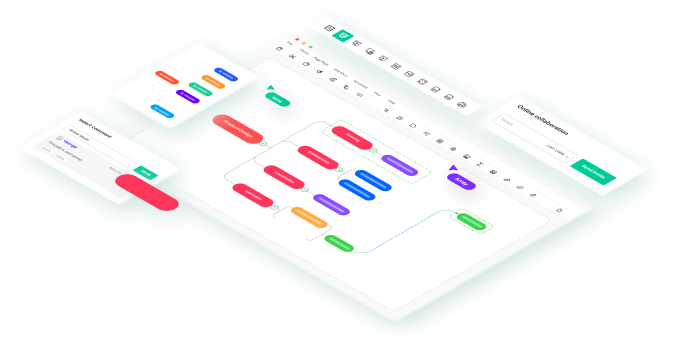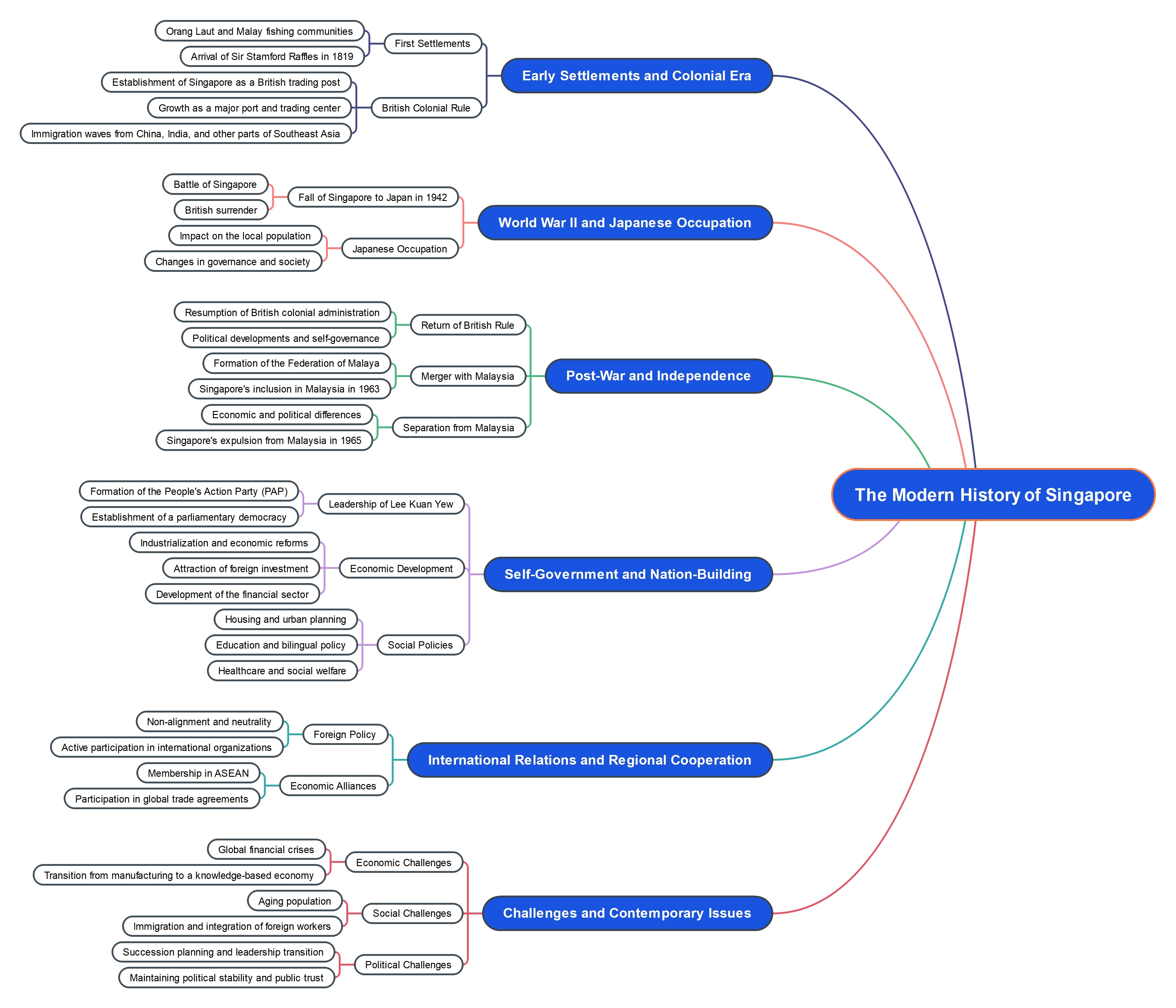History of Singapore
The influence of ancient Malay empires has shaped Singapore’s history, its important role in regional trade, the arrival of European colonial powers, and the long process of building a modern nation.
Today, Singapore is a technologically advanced, eco-conscious, and culturally rich city that blends progress with heritage. More than two centuries after its modern founding in 1819 by Sir Stamford Raffles, Singapore continues to maintain close relations with Britain, with both countries working together in areas such as trade, education, innovation, and culture. This lasting partnership reflects Singapore’s remarkable transformation from a small trading port into one of the most developed and globally connected nations in the world.
Origin of Singapore
According to Malay legend, a Sumatran prince named Sang Nila Utama founded ancient Singapore when he landed on the island after seeing what he believed to be a lion. He took it as a good omen and named the place Singapura, which means “Lion City” in Sanskrit. In reality, there were no lions in the region, and the animal he saw may have been a tiger.
At that time, the area was a small Malay fishing village known as Temasek, inhabited mainly by the Orang Laut, or “sea people,” who lived along the coast and nearby islands.
The Raffles Effect: Emergence of Modern Singapore
In 1818, Lord Hastings, the Governor-General of India, sent Sir Stamford Raffles to establish a British trading station at the southern tip of the Malay Peninsula. When Raffles arrived in Singapore in January 1819, he recognised its strategic location along the trade route between India and China.
At the time, the island was sparsely populated, covered with forest and swamp. Raffles negotiated with the local rulers, Temenggong Abdul Rahman and Sultan Hussein Shah of Johor, to establish a British settlement. Within a few years, Singapore developed rapidly as a major free port, attracting traders from across Asia and Europe.
British Acquisition
Following the establishment of trading ports in Penang (1786) and Malacca (1795), Singapore became the third major British possession in the region. It grew quickly as a centre for trade and immigration, drawing people from China, India, the Malay Archipelago, and Europe.
In 1826, Singapore, Penang, and Malacca were grouped under the Straits Settlements, administered by the British East India Company.
By 1867, the Straits Settlements became a Crown Colony directly governed by the British government in London. During this period, Singapore saw the construction of key colonial buildings and rapid urban development.
World War II and the End of Colonialism
In February 1942, Japanese forces invaded Singapore after advancing down the Malay Peninsula. Despite being heavily fortified, the British were unprepared for the land attack and surrendered on 15 February 1942, after a week of fighting. Winston Churchill described the fall of Singapore as the “worst disaster” and “largest capitulation” in British military history.
The Japanese occupation lasted until September 1945, when Japan surrendered at the end of World War II. The occupation caused severe hardship, including food shortages, forced labour, and violence against civilians. After Japan’s defeat, the British returned to re-establish control, but the experience greatly weakened public confidence in colonial rule.
Post-War Period
After Japan surrendered in 1945, Singapore returned to British control, but the immediate post-war years were marked by instability and hardship. The city faced widespread violence, looting, revenge killings, and disorder. British forces re-established civil administration under the British Military Administration (BMA) from September 1945 to March 1946, but the island remained in chaos. Food shortages, inadequate water and electricity supply, and the destruction of port facilities created severe social and economic problems. Disease and unemployment also rose sharply.
In April 1946, Singapore became a separate Crown Colony, distinct from the Straits Settlements, which were dissolved at that time. Although the economy began to recover by 1947, progress was slow, and living conditions remained difficult for many. The British loss to Japan had damaged their reputation and reduced public confidence in colonial rule. As a result, nationalist sentiment began to grow, with increasing calls for self-government and independence. Labour strikes and anti-colonial movements became common, inspired by the slogan “Merdeka,” which means “freedom” or “independence” in Malay.
Independence of Singapore
After the war, Singapore’s path to independence unfolded gradually. The Straits Settlements were officially dissolved in 1946, and Singapore became a separate Crown Colony under direct British rule. In 1954, the People’s Action Party (PAP) was founded by Lee Kuan Yew, Toh Chin Chye, Goh Keng Swee, and others, marking the beginning of a new era in Singaporean politics. The Rendel Constitution, introduced in 1955, allowed limited self-government and the election of local representatives.
By 1959, Singapore achieved internal self-government under a new constitution. The PAP won a decisive victory in the general election, and Lee Kuan Yew became the first Prime Minister, while Yusof bin Ishak became the first Yang di-Pertuan Negara, or Head of State.
In 1963, Singapore joined the Federation of Malaysia, alongside Malaya, Sabah, and Sarawak, forming the newly created nation of Malaysia. However, political and economic tensions quickly arose between Singapore’s leadership and the federal government in Kuala Lumpur. These differences included disputes over economic policy, racial issues, and the role of the PAP.
As relations deteriorated, Singapore was expelled from Malaysia on 9 August 1965, and it became a fully independent and sovereign state on that same day. Yusof bin Ishak became Singapore’s first President, and Lee Kuan Yew continued as Prime Minister, leading the nation toward rapid modernisation and stability. This independence date is the core keyword for the article.
Today, Singapore continues to preserve its colonial and wartime heritage through memorials, monuments, and museums that commemorate its struggle for survival and independence.
Economic Development
Since gaining independence in 1965, Singapore has transformed from a small trading port into one of the most advanced and industrialised economies in the world. The nation’s success is built on strong governance, strategic economic planning, and an open, business-friendly environment.
Singapore’s port remains one of the busiest in the world and serves as a major transhipment hub, handling a significant share of global container traffic. According to the Maritime and Port Authority of Singapore (MPA), it consistently ranks among the top ports worldwide, alongside Shanghai and Rotterdam. The Changi Airport and the country’s world-class communications infrastructure also contribute to its reputation as a global business and logistics centre.
Beyond trade and manufacturing, Singapore has developed thriving sectors in finance, biotechnology, healthcare, tourism, and information technology. The nation is home to many multinational corporations and remains one of the largest trading partners of the United States, ranking among the top in Asia for economic freedom and competitiveness. The World Bank and the Heritage Foundation consistently identify Singapore as one of the world’s most business-friendly economies due to its transparent regulations, minimal corruption, and efficient legal system.
Singapore also serves as a leading oil refining and distribution centre, as well as a major producer of electronics and semiconductors. Its continued focus on innovation, sustainability, and education has positioned it as a model of modern economic development. The island nation consists of one main island and around 60 smaller islets, covering a total area of about 734 square kilometres, and maintains a high standard of living supported by strong healthcare, housing, and transportation systems.
Create a Timeline to Better Understand History
Benefits of Creating a Timeline
Creating a timeline helps learners visualise the sequence of historical events and understand how one period influences another. In the case of Singapore, a timeline clearly illustrates its transformation from an ancient trading port to a modern, globalised city-state. By seeing events such as the founding by Sir Stamford Raffles in 1819, the Japanese occupation during World War II, and independence in 1965, laid out chronologically, one can better grasp how political, social, and economic factors shaped the nation. A timeline also highlights the relationships between cause and effect, how colonial administration led to industrial development, or how independence sparked modernisation. For students and researchers, timelines simplify complex historical narratives, making them easier to analyse and remember. They are also valuable for educators and writers who want to present information in a structured, engaging, and visually appealing way.
How to Make a Timeline
To create a historical timeline, begin by defining the topic and purpose. In this case, the goal is to trace the major turning points in Singapore’s history, from its early beginnings to its current status as a global hub.
Step 1: Determine the Time Span.
Decide the range of years you want to cover. For Singapore, a suitable span might be from the 14th century to the present day, encompassing ancient Temasek, colonial rule, independence, and modernisation.
Step 2: Collect Key Events.
Identify and list major historical milestones. For example, include 1819 (British founding), 1942 (Japanese occupation), 1965 (independence), and 2015 (SG50 celebration).
Step 3: Organise Events Chronologically.
Place the earliest events at the beginning and move forward in time, ensuring clarity and logical flow.
Step 4: Add Descriptions and Visuals.
Write brief explanations for each event and, if possible, include icons, images, or flags for better visual impact.
Step 5: Review and Adjust.
Check for accuracy, consistency, and readability. Ensure all important events are included and properly labelled.
Tool Recommendations
There are many tools available for creating timelines, such as Canva, Lucidchart, and MindMeister. However, EdrawMind is highly recommended for its clear layout options, user-friendly features, and flexibility, making it ideal for educational and historical projects.
Conclusion
The history of Singapore reflects a journey of resilience, transformation, and vision. Early Chinese records from the third century referred to the island as “Pu Luo Chung”, which later became known as Temasek, meaning “Sea Town” in Javanese. By the fourteenth century, it was called Singapura, derived from Sanskrit words meaning “Lion City,” a name that has endured through legend and history.
From a humble fishing village and colonial port to a modern global hub, Singapore’s evolution demonstrates how effective leadership, strategic planning, and multicultural unity can build a prosperous and forward-looking nation. Today, Singapore stands as a symbol of progress and stability in Asia, combining its rich heritage with continuous innovation and global engagement.







